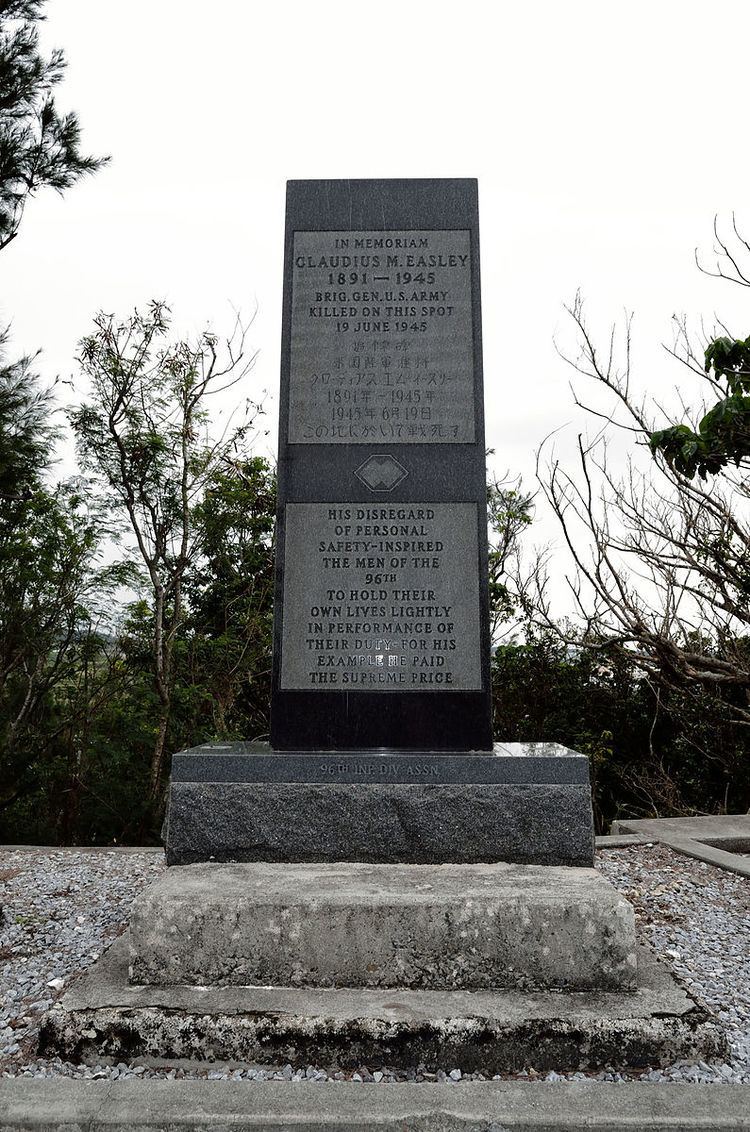Allegiance United States Name Claudius Easley | Died June 19, 1945 Rank Brigadier general | |
 | ||
Born July 11, 1891Thorp Springs, Texas, United States ( 1891-07-11 ) Battles/wars Mexican Border serviceWorld War IIBattle of Okinawa | ||
Brigadier General Claudius Miller Easley (July 11, 1891 – June 19, 1945) was a decorated United States Army officer who was killed in action by the Japanese during the Battle of Okinawa.
Contents

Early life and military career
Claudius Miller Easley was born on July 11, 1891 in the small village of Thorp Spring, Hood County, Texas as the eldest son of Alexander Campbell Easley and his wife Claudia Miller. His family later moved with to Waco, Texas when Easley was at a very young age. He subsequently attended local Waco High School, where he graduated in 1911. During his time at high school, Easley enlisted in the Texas National Guard and participated in Rifle-marksmanship competition at Camp Perry, Ohio. He was later commissioned as an officer, with the rank of second lieutenant in the Infantry Branch on July 11, 1912, his 21st birthday.
He later attended the Agricultural and Mechanical College of Texas and graduated in 1916 with a Bachelor of Science in Architectural Engineering Degree. With the graduation from college, Easley decided for active service in the United States Army. He served first with the Texas Army National Guard on the Mexican Border and while he was commissioned in the Regular Army in 1917, shortly after the American entry into World War I, he remained for further border patrol duties with the 37th Infantry Regiment, not seeing service in World War I.
Between the wars
Easley was then sent to the U.S. Army Infantry School at Fort Benning, Georgia, where he graduated from the Advanced Infantry Course in 1919.
In 1921, Easley was transferred to the Philippines, where he was assigned to the 31st Infantry Regiment, then stationed at Fort William McKinley. He served three-year tour of duty in Manila, before he returned to the United States. He also attended the U.S. Army Command and General Staff School at Fort Leavenworth, Kansas in 1925. He was subsequently assigned to the 4th Infantry Regiment at Fort George Wright, Washington. It was followed by short period of duties with the 30th Infantry Regiment at Presidio of San Francisco, California.
In 1930, he was appointed an Instructor in the Weapons Section of the U.S. Army Infantry School at Fort Benning, Georgia and served in this capacity until 1934. He was later appointed a commander of the Los Angeles District of the Civilian Conservation Corps. As an avid and experienced marksman, Easley served as Captain of the Infantry Rifle and Pistol Teams during the years 1937-1939. He was subsequently ordered for studies at U.S. Army War College in Washington, D.C. and graduated in 1940.
World War II
After his graduation, Easley remained in Washington, D.C., because he was assigned to the War Department General Staff, where he was responsible for the Storage Section of Requirements and Distribution branch of the Supply Division. He stayed there until February 1942, when he was transferred to Camp Claiborne, Louisiana, where he was appointed as commander of the 325th Infantry Regiment, which later became the 325th Glider Infantry Regiment when the regiment's division, the 82nd Infantry, became the U.S. Army's first airborne division and was redesignated the 82nd Airborne Division.
In September 1942 Easley was transferred to Camp Adair, Oregon, where he was appointed Assistant Division Commander (ADC) of the 96th Infantry Division. He was also promoted to the one-star general officer of brigadier general.
Brigadier General Easley personally supervised the 96th Division's marksmanship training and helped to keep the high level of markmanship. Thus division gained the nickname "Deadeyes". Easley also participated in the Oregon Maneuver during the fall of 1943. The 96th Division was sent to Hawaiian Islands in July 1944 for preparation for landing in Philippines. Brigadier General Easley subsequently went ashore during the Battle of Leyte and was wounded by enemy sniper fire. He was later decorated with the Legion of Merit for meritorious conduct and leadership and the Bronze Star for gallantry in action.
Easley remained in command and later participated in the Battle of Okinawa, where he was decorated with the Silver Star for gallantry in action. During the final phase of the battle, Easley personally directed fire on the last enemy positions. While assessing the battle situation, he was shot in the forehead by enemy sniper fire on June 19, 1945. He was the second general officer killed in action during one week on Okinawa. He was buried at Okinawa, but later reburied at Arlington National Cemetery, Virginia.
He was survived by his wife Inez Wickline (1895-1979) and his son Claudius Miller Easley, Jr. (1918–2006), who served as a lieutenant colonel with Sixth Army. On April 21, 1946, Easley was posthumously awarded a Doctorate of Laws by AMC.
Decorations
Here is Brigadier general Easley´s ribbon bar:
